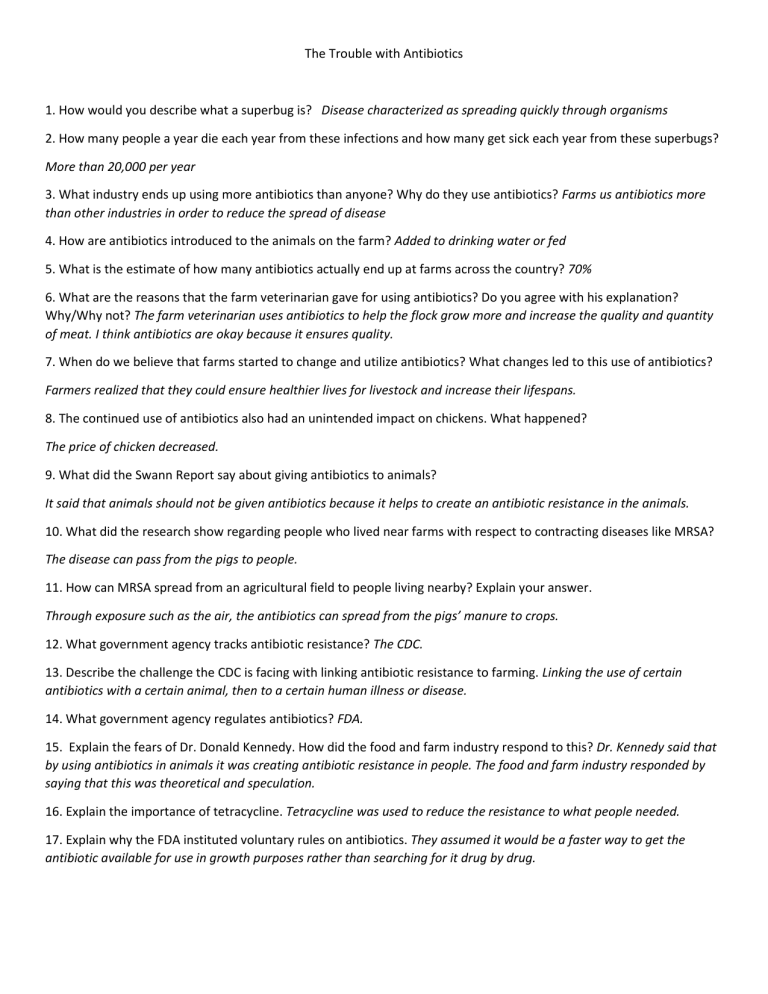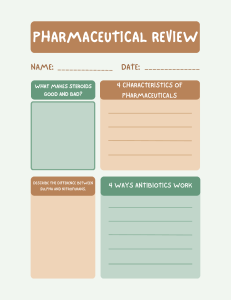
The Trouble with Antibiotics 1. How would you describe what a superbug is? Disease characterized as spreading quickly through organisms 2. How many people a year die each year from these infections and how many get sick each year from these superbugs? More than 20,000 per year 3. What industry ends up using more antibiotics than anyone? Why do they use antibiotics? Farms us antibiotics more than other industries in order to reduce the spread of disease 4. How are antibiotics introduced to the animals on the farm? Added to drinking water or fed 5. What is the estimate of how many antibiotics actually end up at farms across the country? 70% 6. What are the reasons that the farm veterinarian gave for using antibiotics? Do you agree with his explanation? Why/Why not? The farm veterinarian uses antibiotics to help the flock grow more and increase the quality and quantity of meat. I think antibiotics are okay because it ensures quality. 7. When do we believe that farms started to change and utilize antibiotics? What changes led to this use of antibiotics? Farmers realized that they could ensure healthier lives for livestock and increase their lifespans. 8. The continued use of antibiotics also had an unintended impact on chickens. What happened? The price of chicken decreased. 9. What did the Swann Report say about giving antibiotics to animals? It said that animals should not be given antibiotics because it helps to create an antibiotic resistance in the animals. 10. What did the research show regarding people who lived near farms with respect to contracting diseases like MRSA? The disease can pass from the pigs to people. 11. How can MRSA spread from an agricultural field to people living nearby? Explain your answer. Through exposure such as the air, the antibiotics can spread from the pigs’ manure to crops. 12. What government agency tracks antibiotic resistance? The CDC. 13. Describe the challenge the CDC is facing with linking antibiotic resistance to farming. Linking the use of certain antibiotics with a certain animal, then to a certain human illness or disease. 14. What government agency regulates antibiotics? FDA. 15. Explain the fears of Dr. Donald Kennedy. How did the food and farm industry respond to this? Dr. Kennedy said that by using antibiotics in animals it was creating antibiotic resistance in people. The food and farm industry responded by saying that this was theoretical and speculation. 16. Explain the importance of tetracycline. Tetracycline was used to reduce the resistance to what people needed. 17. Explain why the FDA instituted voluntary rules on antibiotics. They assumed it would be a faster way to get the antibiotic available for use in growth purposes rather than searching for it drug by drug. Outbreak at NIH 1. What is the superbug found in many hospitals in New York? Where do doctors typically find this bug? KPC, Normally found in the digestive system. 2. Why is bacteria so easily spread in hospitals? Many people in hospitals are more easily susceptible to being affected by bacteria, making it easier for people within a hospital to catch it. 3. What procedures did the hospital introduce to help fight the KPC epidemic? They separated those effected by KPC and used machines rather than people to clean out the rooms to resist the human contact. 4. Explain what the silent carriers were. People who carry KPC while showing no symptoms. 5. What measures did the hospital think about doing in order to fight the KPC bug? Closing the hospital and expand research. 6. What do you think can be done at hospitals to help fight these superbugs? It could be important for there to be a consistent standard of cleaning in the hospitals to reduce the spread. 7. After watching the first part of the video, do you believe there is a correlation between agriculture’s use of antibiotics and the creation of drug resistant bacteria? Why/Why not? I would say there is a correlation between the two because using antibiotics increases the level of resistance.




